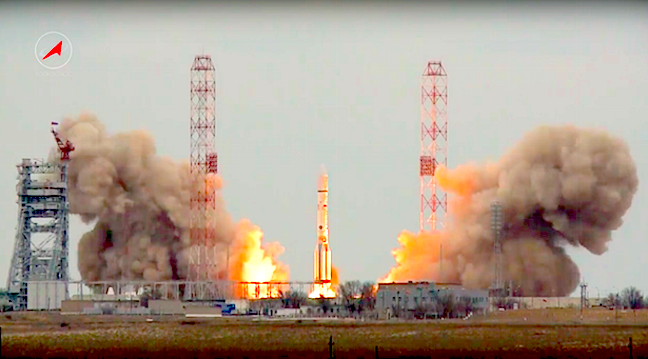
Courtesy of Roscosmos.
The launch was delayed yesterday due to an automatic abort that was triggered moments before ignition of the Soyuz rocket’s engines that halted the countdown. Such launch scrubs late in the countdown are rare for the nearly six-ton workhorse, Soyuz booster, which usually launches more often than any other rocket in the world.
The satellite’s Soyuz booster steered north from Baikonur, and dropped its four first stage engines about two minutes after liftoff. The second stage core engine, and a third stage propulsion system delivered the Resurs P3 satellite to a preliminary orbit about 9 minutes, 21 seconds into the flight, according to a statement by Roscosmos, the Russian space agency.
The Baikonur Cosmodrome is a busy place. Another launch is due to lift off tomorrow from a different sector of the cosmodrome with an European-led Mars mission named ExoMars.
Resurs P3 will collect black-and-white imagery with a resolution of 1 meter, or 3.3 feet, and analysts will resolve objects as small as 3 to 4 meters (10 to 13 feet) across in color pictures.
Russian government agencies responsible for agriculture, the environment, emergency situations, fisheries, meteorology and cartography will be consumers of data from Resurs P3, which will join two similar satellites—named Resurs P1 and Resurs P2—launched in June 2013 and December 2014. A telephoto camera with a focal length of 4,000 millimeters will take the highest-resolution images.
Data from the Resurs satellites aid in disaster response, help authorities update maps, track pollution, track ice in maritime shipping lanes, and detect fields of illegal drugs, according to TsSKB Progress.
Made by TsSKB Progress, a company based in Samara, Russia, the 5,730-kilogram (12,632-pound) Resurs P3 satellite hosts a suite of digital cameras.
One is tuned to image the Earth in 96 spectral bands, obtaining details on metrics such as crop yield, vegetation health, microbial activity in water, and assessing the impacts of invasive insects on agriculture.

